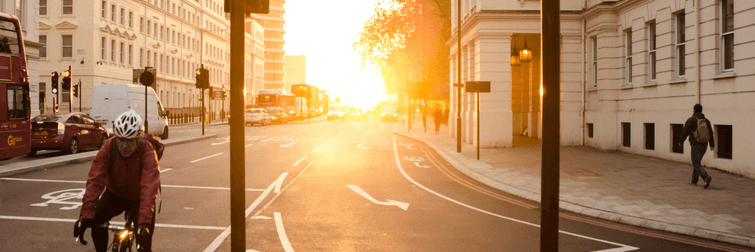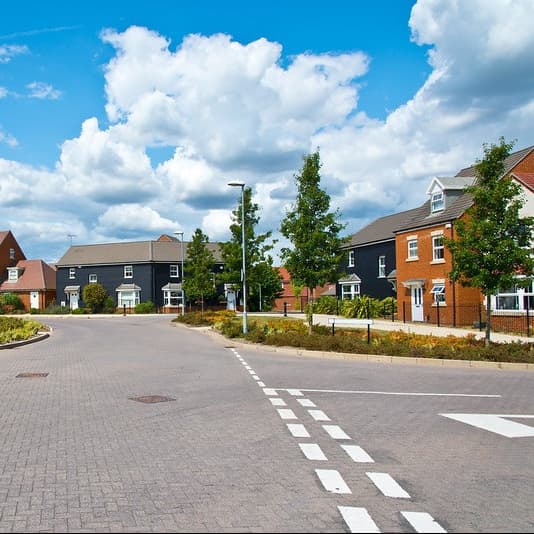
blog: Imagine there’s a new planning system…
Monday 17th August 2020
A week has now passed since the Ministry of Housing, Communities & Local Government (MHCLG) published its white paper to consult upon proposals for wide-ranging reforms to the planning system in England.
Reaction has been mixed, with some commentators applauding the ambition and vision for a simpler system that is easier for planning authorities to apply and developers to interpret, while others decried the over-simplification of detail needed to provide the checks and balances that can help to facilitate ‘good growth’.

For what it’s worth, here is ITP’s view on the proposals – derived from our perspective as sustainably-focused transport planners who believe growth can be directed to improve mobility outcomes and reduce the car dominance which has been ‘designed-in’ to UK society in recent decades.
… its’ actually quite hard to do
What struck us immediately is that these are very much ‘planning-led’ reforms. None of MHCLG’s panel come from a sustainability or transport/infrastructure background and, perhaps consequently, there are only five references to ‘transport’ and two references to ‘carbon’ in the whole 84-page document.
Encouragingly for sustainable transport planners, one of these (on page 29) notes the importance of maximising walking, cycling and public transport opportunities when identifying land for inclusion within the growth area, or the densities of development appropriate in different locations. Our excitement is tempered slightly by the similarity of wording in the existing National Planning Policy Framework and accompanying guidance, which have all too often failed to deliver high quality or sustainable places.
A number of sensible measures – including standard templates for Local Plans and greater use of digital, map-based, plans – are warmly welcomed. Greater transparency over the consent-status of development sites and value of contributions secured also seems eminently sensible and the commission should be commended for their willingness to ‘think big’.
However, even these positives are not without challenge. Local planning authorities, whose budgets have been declining in real-terms over the last decade and whose revenues from parking and other assets have been severely hampered by the COVID19 pandemic, will doubtless highlight the need for central Government funds to update IT systems and support staff training and skills development. Developers and promoters may also resist the publication of negotiated contributions – something the singular (likely to be zoned?) infrastructure levy proposal may be intended to overcome. However, we struggle to see how a levy set nationally can resolve the challenges of identifying the viability of individual sites.
Imagine all the challenges…
We agree with the contention that the current planning system is too complex and bureaucratic and while the white paper identifies some key issues, it remains silent on what we consider two critical weaknesses from a sustainable mobility perspective; Green Belt policy and the call for sites.
Many Local Plans do not start life with a truly objective analysis of which locations will genuinely create places where scope to maximise walking, cycling and public transport use for everyday journeys can be realised. Instead they tend to be hampered by having half an eye on green belt designations that are considered sacrosanct (and it appears will remain so), coupled with practically-focused awareness of which sites are already being promoted for growth allocations.
It remains unclear whether the intention to allow local authorities to designate land into three categories (growth, renewal and protection) will continue to acknowledge, or ignore, these spatial considerations. If they continue to be accounted for from the outset, then the chances of ‘the right locations’ being allocated as potential development sites remains slim.
Most fundamentally perhaps, the changes being proposed assume the planning system is the reason why we are not building enough homes. In practice though most applications are granted - well over 300,000 homes per year have been consented in recent years, with over 1,000,000 homes granted permission but not constructed over the last decade. It is possible to politely question whether the issues identified lie solely at the planner’s door.
… and policies replaced by rules
The proposal to streamline the Local Plan-making process, and truncate the size of plan documents, in part through the adoption of a rules-based approach – ditching the current use of policies – sounds sensible to us. It does remain to be seen how achievable this will truly be in tandem with a (positive) shift away from ‘tickbox’ statutory public consultation to participatory engagement with a more representative group of stakeholders. ITP’s experience is that meaningful engagement takes just as long (if not longer) than the consultation processes currently used to guide the development of Local Plans, but the more useful outcomes justify this approach.
Much will also depend on whether the rules that are now to be defined in Local Plans (rather than Supplementary Planning Documents and Development Briefs) are backed by regulatory ‘teeth’ that ensure compliance. This reflects our experience that it is currently relatively easy for developments to demonstrate compliance with policies intended to maximise sustainable mobility outcomes, whilst still generating high levels of on- and off-site car use to the places people actually want (or need) to travel to on an everyday basis.

Imagine all the beauty…
Consultants across the land will be salivating at the prospect of helping every planning authority to develop a local design guide – seeking to codify their interpretations of beauty and good growth. While some progressive local authorities already have these, most seek to specify such requirements through site-specific SPDs and Development Briefs. Our own experience of working with multiple local authorities to develop design guides is that these are not straightforward to create, or to encourage designers and engineers to adopt in practice.
Indeed, the ‘B-word’ crops up 36 times in the white paper, with a proposal to fast-track developments that are considered ‘beautiful’. This clearly draws on the work of Governments’ Building Better, Building Beautiful Commission, and could be read as a determined effort to incentivise some of the volume house builders to sharpen their architectural and landscape design pencils.
… but who gets to decide?
Perhaps ironically though, not that many of the glossy images of developments included within the white paper struck us as being especially ‘beautiful’ in sustainable transport terms. Examples of attractive architecture and landscaping abound, but very few images showed a mix of homes, workplaces, convenience retail and community facilities co-located in people-focused settings that prioritise walking and cycling above all other forms of travel. Few images depicted homes that are delivered at densities which support commercially-viable public transport links to nearby settlements, or showed sympathetically designed bus/LRT routes that permeate through the heart of developments. Indeed, many of the photos depict housing estates with streets designed primarily for cars that have no pedestrian footways or dedicated cycle routes.
Maybe this just depicts the best of what has been achieved within the constraints of the current planning system? Either way, the visuals in the document itself neatly encapsulate the challenge of defining beauty from a perspective of planning and development outcomes.
You may say I’m a dreamer…
Despite the many questions presented by the proposed reforms, they do appear to offer a platform from which positive changes can be realised. Simplified land-use characteristics and designations, coupled with renewed focus on climate-resilient design and an intention to ‘make’ places that are sustainable for the long-term should (in theory at least) help to push sustainable mobility considerations higher up the order when it comes to allocating land for development.
We’ll be distilling our thoughts further into a consultation response for MHCLG, but our emerging high-level recommendations include:
- The need for planning system reforms to enable local authorities to play a more proactive role in the coordination of development across multiple sites/phases within large sites. In our view this is where greatest scope exists to achieve direct, convenient and cohesive cycle network and local public transport routes that offer a genuine alternative to private car use. Too often this is where opportunities are currently being missed.
- The need for a serious re-think on Green Belt policy – recognising that some cities and large towns need to be allowed room to continue to expand if the right type of development in edge of town/city locations can maximise scope for walking, cycling and public transport behaviours. This is particularly significant if the duty to cooperate is really to be removed.
- The clear need to back sweeping planning system reforms with funding to support planning authorities who need to build capacity and expand their IT capabilities if the intent of the reforms are to be realised and to deliver sustainable transport infrastructure at a much greater scale and scope than new roads which are designed primarily to carry private motorised trips and those generated by online shopping behaviours.
… but I’m not the only one
At the time of writing MHCLG is inviting responses to its consultation on proposed Planning reforms, which is due to close on 29th October 2020. If you’d like to discuss your response to the consultation, or how ITP’s views might be pertinent to your organisation, then please get in touch with one of our sustainable transport strategy experts:
Jon Parker parker@itpworld.net
Neil Taylor taylor@itpworld.net
Geoff Burrage burrage@itpworld.net
